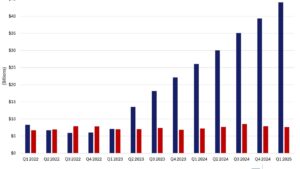Today’s announcement that the Consumer Price Index (CPI) hit 9.1% was so severe that there is now credible speculation that the Federal Reserve will raise the fed funds rate by 1.00% instead of the planned .75% which would still represent a huge increase. We warned that inflation was large, understated, a huge problem, and not transitory back last November, and yet, every month it seems that people are surprised that inflation is an issue. To give you a sense of the level of surprise, when we wrote our initial piece on inflation, many economists and Wall Street analysts expected the Fed to raise rates by a TOTAL of .75% in 2022. We got that amount last month alone, and are going to get at least that much again later this month.
It’s not just the US either. Today, John Davitsky, a Director at Echelon Wealth Partners, emailed to let us know the Bank of Canada had raised rates by 1.00%, the largest increase in more than 20 years.
Even worse, the enormous 9.1% number is still understated. Shelter (housing) which makes up 32% of the index was officially up 5.7%. That’s not accurate. The Case-Shiller U.S. National Home Price Index is up 20.4%. The Case-Shiller Index is always reported a couple of months late, but that’s a big difference. There are two reasons for this. First, in an issue we’ve discussed many times on this blog, there was a change to the CPI in the late 1990s to shift from actual cost of housing to something called “Owners Equivalent Rent” which routinely understates the increase in housing prices. Second, because most rental contracts are for a year, the actual rent that people pay hasn’t fully adjusted to the new higher prices yet. If we were to calculate the CPI using the same methodology the US Bureau of Labor Statistics used in the 1970s and 1980s, the CPI would be 13.8%.
We’re also skeptical regarding the calculation of food inflation. The latest report shows all food prices up 10.4% and food at home up 12.2%. We started expressing doubt on these numbers months ago when the official numbers were closer to the 5% – 6% range. Actual food prices both in the supermarket and in restaurants have been trending ahead of the Bureau of Labor Statistics numbers, and we continue to maintain that the actual inflation rate is in the mid-teens.
Economists and sell-side analysts have been calling “peak inflation” for months trying to call the top. As today’s new 40-year-high number shows, they’ve been wrong the whole time. Today’s “analysis” was that this time we are seeing “peak inflation” because commodity prices have come down in the last month. Our response is “maybe”. Gasoline prices have come down in the last month and we’re seeing more prices in the $4.50 per gallon range than the $5.00 or more we saw a month ago. Even at $4.50, that still a big increase over last year.
The peak inflation crowd is also pointing to other lower commodity costs as a reason for hope. Some of that is correct, but not encouraging. It’s true that grain prices have come down from their highs, but there’s a lot of Ukrainian wheat that didn’t get planted last spring that won’t get harvested next month, and lack of availability of Russian fertilizer will hurt crop yields in the US. Copper prices have come down, but that’s partly related to China’s continuous Covid shutdowns, and partly related to a slowing of economic activity. (More on that below).
Even if commodity prices stay lower than they were a month ago, there’s a lot of inflation in the services part of the economy, and that’s not tied to commodities. We spoke with a former hospital CEO today who talked about how higher labor and materials cost had made many hospitals unprofitable. He pointed out that even non-profit hospitals can’t run losses indefinitely, and that means that either our healthcare services costs are going to go up, or we’re going to have to start waiting longer to receive medical care as facilities close. There’s not much interest rate increases can do about that.
In the end, we’ve said that Fed rate hikes are going to work if we’re measuring success by reducing inflation. The big problem we’re going to face is that interest rate increases reduce economic activity, and we’re already experiencing stagflation (high inflation combined with negative economic growth). The best way to reduce inflation would be to encourage more production, but that’s beyond the ability of the Fed. Eventually (or possibly this month), the “peak inflation” crowd will be right, and inflation will come down. The negative for that is it will be accompanied by higher unemployment and lower earnings. That’s the point we made last month when we noted that despite higher costs for labor, energy, and materials, and declining economic growth, S&P 500 earnings estimates still haven’t come down. The sell-side analysts are late and optimistic again.



